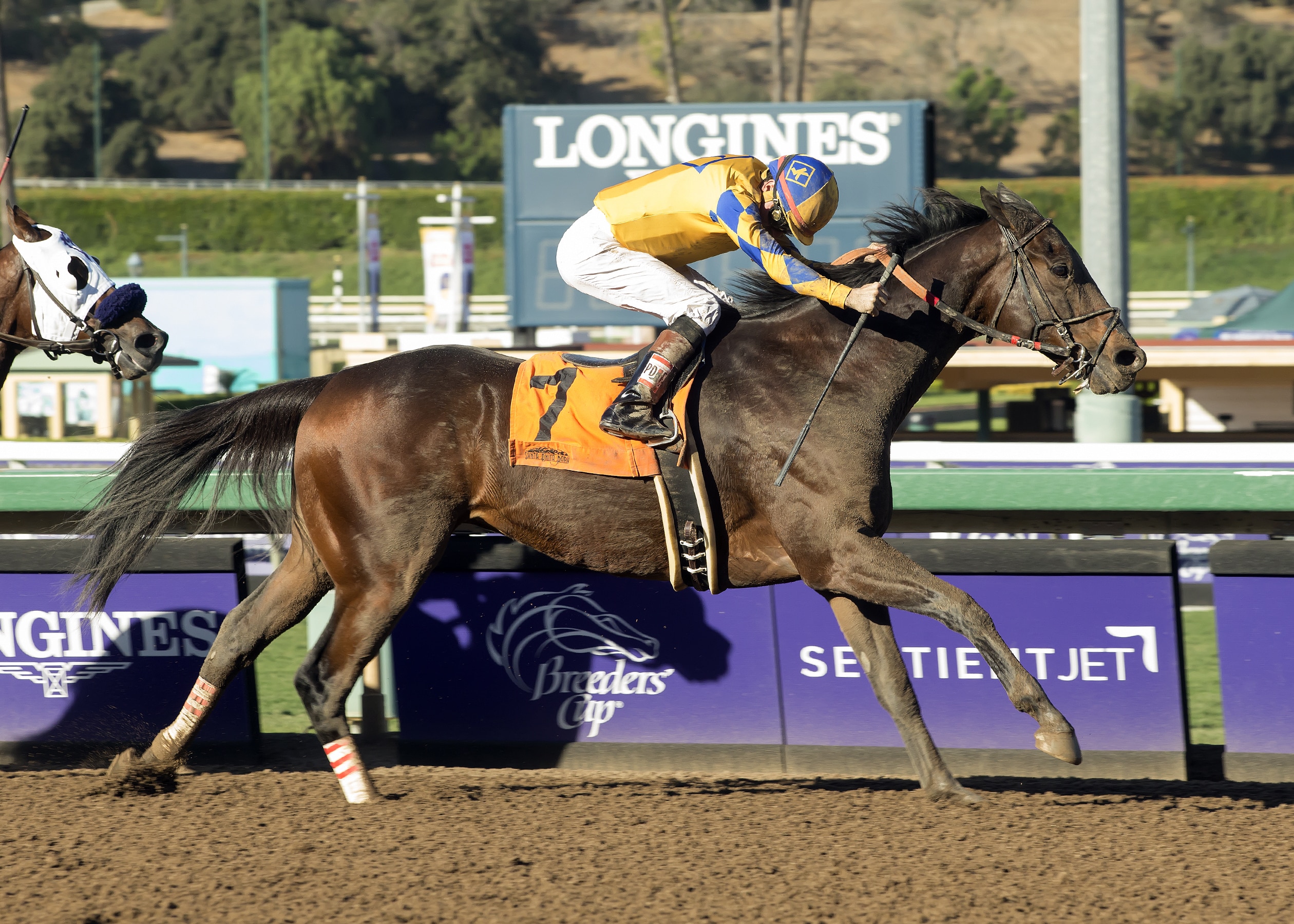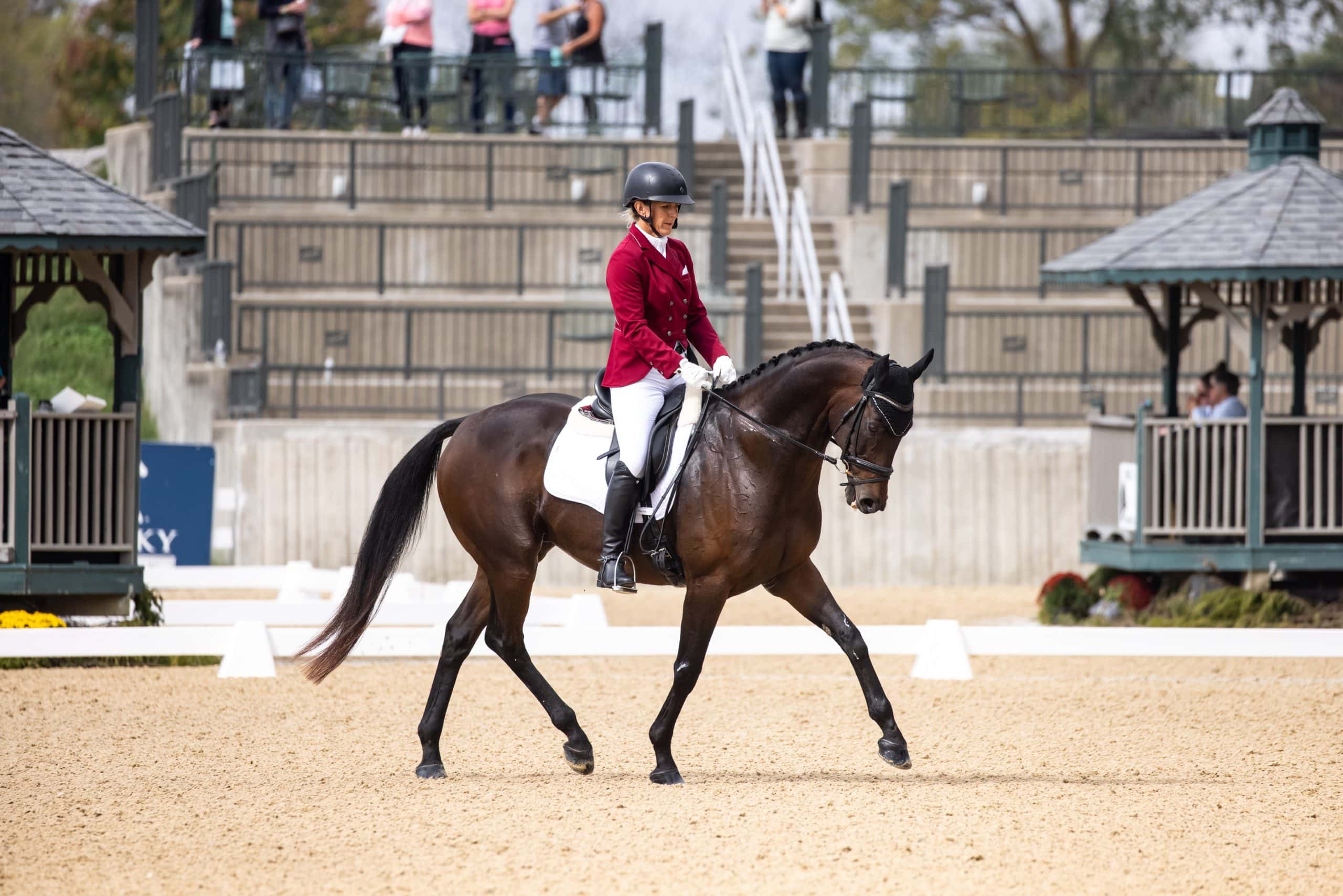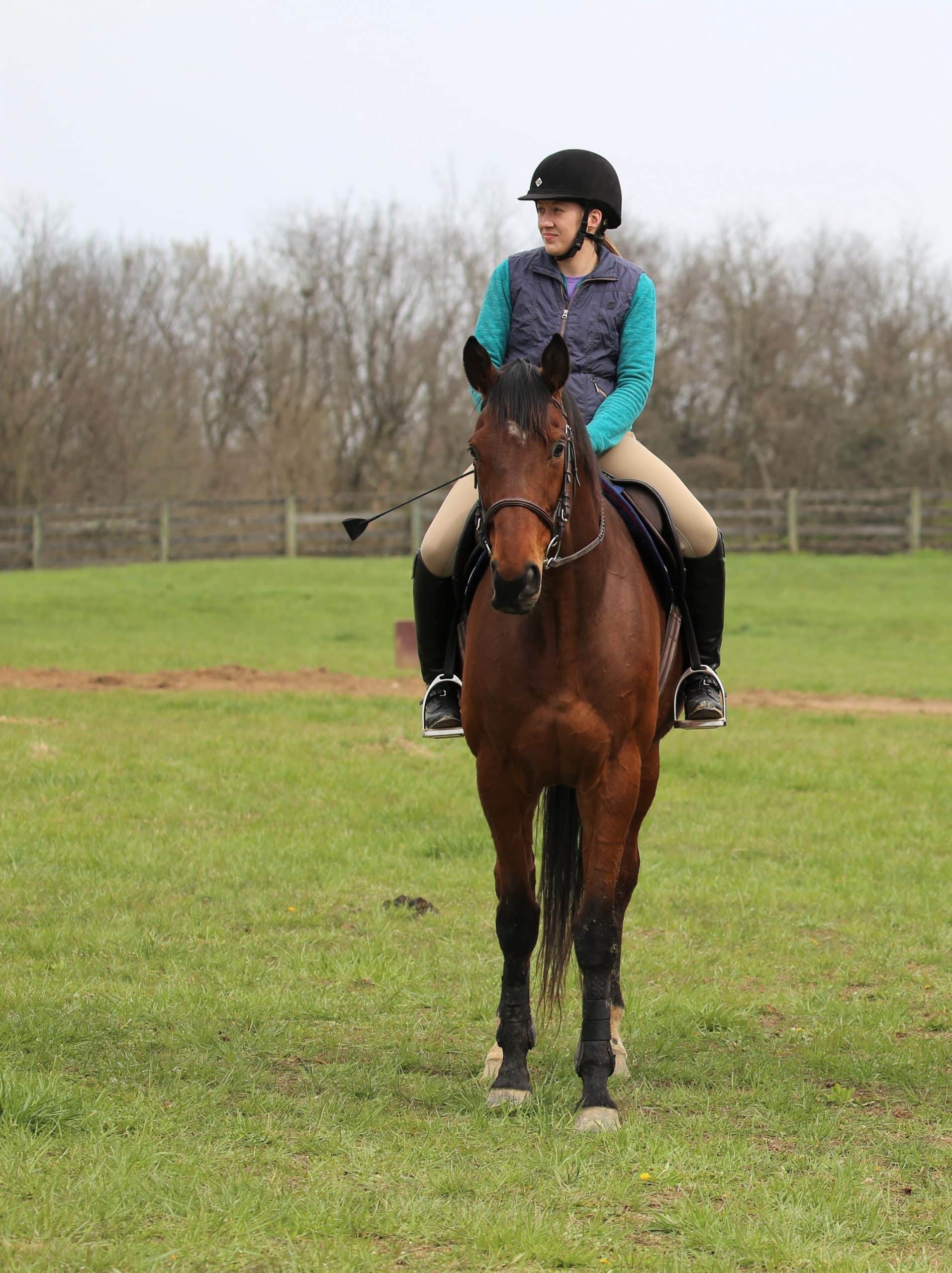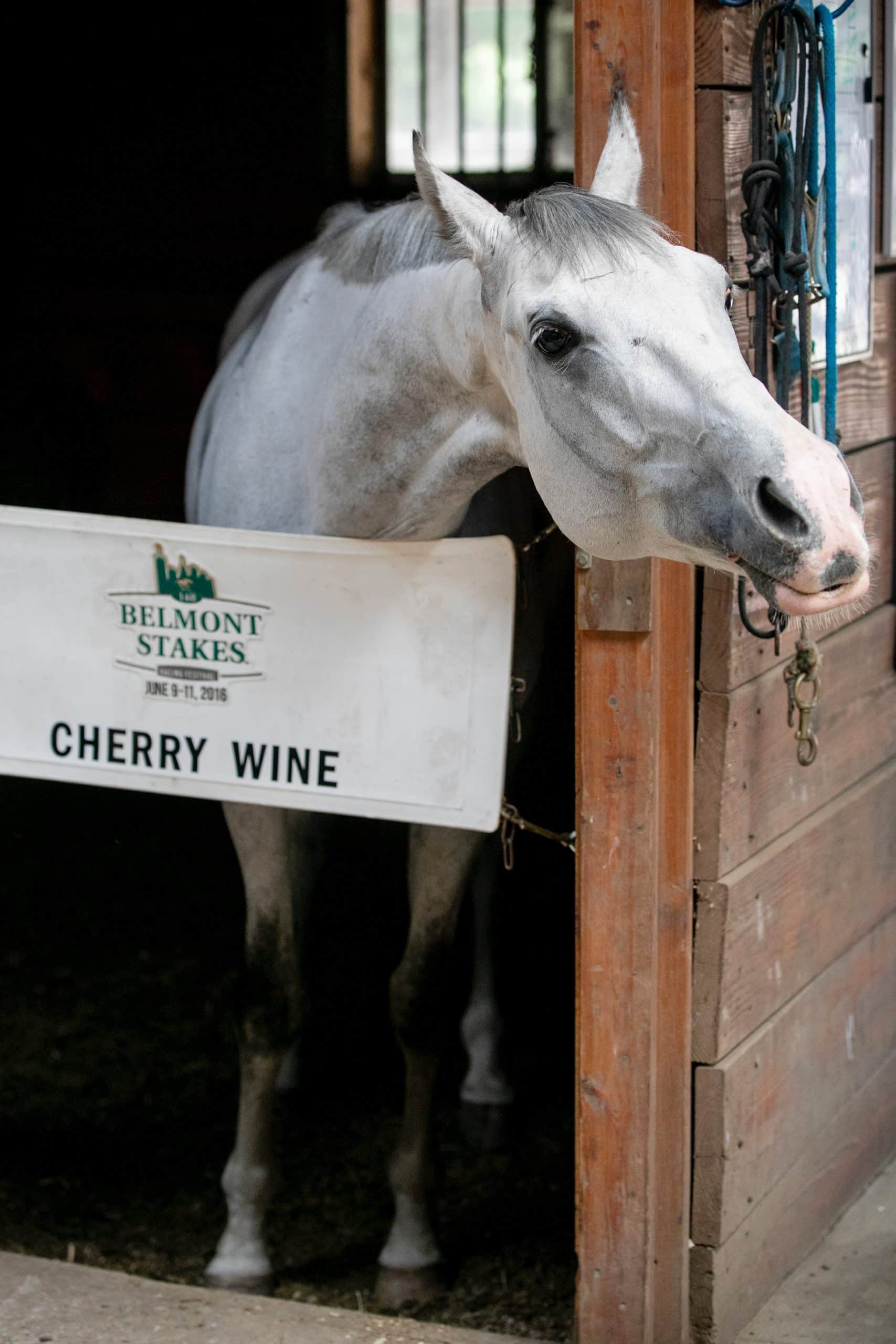
Imperative, who earned more than $3 million on the track, now competes in dressage with Louise Adkins. Courtesy Benoit Photo
The Thoroughbred is a horse designed for an active lifestyle, the product of generations of breeding to develop the ultimate athlete. That active life might begin on the track, but for the thousands of Thoroughbreds not destined for breeding careers, it often continues in an arena when they exit racing — whether the horse never broke his maiden or earned hundreds of thousands of dollars in graded stakes company. Aftercare is for all Thoroughbreds, no matter the level of racing they achieve.
Meet three graded stakes winners whose careers have continued in new disciplines after their racing achievements made them household names.
Imperative

Photo by Bethany P Photography
Imperative’s list of achievements is eye-opening: Three-million-dollar earner, multiple graded stakes winner, Breeders’ Cup Classic participant. On top of all that, he’s a war horse with 50 career starts. It sounds like the makings of a prospective breeding stallion’s resume, except for one catch: Imperative is a gelding. A stud career was not in the cards for him at the end of his racing days.
Bred in Kentucky by Glencrest Farm and Darley, Imperative (Bernardini — Call Her, Caller I. D.) sold as a yearling in 2011 for $325,000. He raced lightly as a 2-year-old, including a start in the Grade 1 FrontRunner Stakes, then raced in allowance optional claimers throughout his 3-year-old season. He was claimed for $50,000, and under the guidance of new connections moved back up to graded stakes company, scoring his first major victory in the Grade 2 Charles Town Classic Stakes in 2014. His career took him coast to coast as well as to Japan; ultimately, Imperative racked up seven wins, including two graded stakes and two black types (races of importance).
Geldings who retire sound typically have a host of second-career options available to them, but Imperative’s glittering career made him appealing to Old Friends, a permanent sanctuary program in Kentucky that showcases well-known retirees for fans to visit. However, racing owner Ron Paolucci stated in a press release that the gelding wanted a job — and that’s where National Thoroughbred Welfare Organization (NTWO) stepped in to help.
“Having that caliber of horse in a second career adds positivity to racing,” says NTWO president Victoria Keith. “Imperative was a good horse to serve as an ambassador.” Through mutual connections, NTWO offered Imperative the opportunity to move into a second career, and in August 2019 his next chapter began.
Professional dressage trainer and veteran Thoroughbred Makeover participant Louise Atkins was looking for her 2020 Makeover prospect at NTWO when they casually introduced her to Imperative, who at the time was aimed at the Makeover with NTWO’s trainer, Tayja Smith. A few months later Atkins got a message she wasn’t expecting — would she be interested in taking Imperative to the 2020 Makeover herself?
Atkins applied to the waitlist — she already had her 2020 trainer slot filled with another horse — and Imperative arrived at her Cobalt Stables in Glenmoore, Pennsylvania, in March. “He was hairy, and his tongue came straight out of his mouth,” Atkins recalls. “He went around with his head up in the air, and I thought, ‘What have I gotten myself into?’ But within two or three rides, suddenly it clicked for him.”
The original arrangement had Atkins preparing Imperative for the 2020 Makeover, then the horse would return to NTWO to serve as an ambassador for aftercare and represent the organization. When the pandemic forced the postponement of the 2020 event, however, Imperative’s fate took another turn: He moved permanently into Atkins’ barn, with NTWO facilitating transfer for $1.
“We felt so safe and comfortable with him in Louise’s hands, and they’re an excellent match,” says Keith.
Atkins agrees that she and Imperative are a match made in heaven. “We call him ‘The Mayor,’ ” she says. “The whole barn runs around him and probably always will. We’re like an old married couple now.”
Atkins and Imperative laid down a solid performance in dressage at the Makeover in 2021, though he was a bit tense in the big atmosphere of the Rolex Arena. Since the Makeover Atkins has moved him into recognized dressage competition. “We’re taking the proper route,” she says. “My overall goal is to see how far he’ll go. We’ve got our scores at first and second level for our (United States Dressage Federation) Bronze medal, and we’re schooling third level this winter with a goal to compete at third level in 2023. The judges are tough in recognized competition, but he is so elegant that they want to score him well.”
While Imperative stays healthy and strong, Atkins believes he’ll let her know when he’s gone as far as he can. “He has such a work ethic,” she says. “He’s too smart — he learns the dressage test! I truly believe he loves to work and loves to learn; he likes to show off what he knows.”
Paolucci’s instinct that Imperative would enjoy a second career has so far turned out to be correct. “He would be miserable if he were just turned out,” Atkins says. “He’s so competitive. He’s not ‘done’ at all. I say all the time, ‘I’ve got to find another one,’ but there’s no one like him. I don’t know how I got so lucky.”
Cary Street

Stephanie Butler and Cary Street have done “a little bit of everything,” from hunter paces to local fun shows and lots of trail riding. Courtesy Stephanie Butler
Racing fans will likely get chills rewatching the 2014 Grade 2 Las Vegas Marathon Stakes, in which Cary Street (Smarty Jones — Shady Reflection, Sultry Song) trails the field until the final half mile, then finds a new gear and launches past the fading pack as if from a cannon. “Cary Street has now come out of the clouds!” the race caller exclaims.
Bred by Darley, Cary Street sold as a yearling in 2010 for $60,000 and again as a 2-year-old for $32,000. Brendan Walsh claimed the gelding as a 4-year-old early in 2013 for just $10,000. Realizing the horse’s knack for running distance races, he trained Cary Street to two graded stakes wins in 2014 — the Grade 3 Greenwood Cup Stakes and the Marathon on the Breeders’ Cup undercard. Cary Street was Walsh’s first graded stakes winner.
The horse would go on to make three more starts in 2015 and one in 2016 before suffering a left front suspensory branch injury. While Walsh and his team discovered the injury early, it was time for the 7-year-old gelding to find a new career. That was when Stephanie Butler, DVM, cVMA, connected with the horse.
“I was working my first veterinary job after internship,” says Butler, who at the time worked for a small racetrack practice whose clientele was primarily race trainers at Keeneland. Peripherally, they knew of Walsh and his reputation for horsemanship. “Friends of mine who exercise rode for Brendan told me, ‘He has a horse for you.’ ”
Walsh felt Cary Street would rather have a productive career than simply be fully retired. “Initially they thought he might make a pony horse, but he doesn’t always take his job seriously,” says Butler. “He’s a little too goofy to be a reliable pony.”
Butler was invited to see “Cary,” who was turned out to rehabilitate at a local farm. Trusting Walsh’s horsemanship and getting to speak with the veterinarians who diagnosed the suspensory branch injury confirmed to Butler the horse would come sound — and hearing reviews from Walsh’s team confirmed he was a special horse.
“I got to speak with his groom and exercise rider, and everyone loved him,” she says. “They thought he was just the neatest horse. I brought him home in summer of 2016.”
While Butler is quick to describe herself as “not much of a horse show rider,” she nonetheless spent 2017 preparing Cary Street for the Thoroughbred Makeover, discovering what helped the horse thrive. “He likes a job that’s mentally stimulating but not physically hard. He turned out to really enjoy trail; he didn’t mind jumping, but it wasn’t ever his favorite thing.”
With the horse’s penchant for trail and enjoyment of activities like hunter paces, Butler pointed him to Competitive Trail and Field Hunter at the 2017 Makeover, and made an excellent showing: They finished 11th in Field Hunter and fifth in Competitive Trail, earning top-placed amateur honors in the latter division. Since then Butler’s done a little bit of everything with Cary, from hunter paces to local fun shows and lots of trail riding.
“He has to be in the right mood to be convinced to extend himself,” Butler says. “A lot of my friends will ask, ‘This was a racehorse?’ They don’t believe it until they watch his racing videos.”
In 2020 Cary sustained a collateral ligament injury in his coffin joint during turnout and, while he’s rehabbed well and is sound, Butler chose to retire him from jumping. She sees a future for him as her fiance’s trail horse while she brings along another OTTB for herself. No matter what lies in Cary’s future, his personality will always endear him.
“They called him ‘Carrot Street’ at the track,” Butler says with a laugh. “He had the first stall right next to the office, and when he heard a carrot snap he was right there for his treat. He always comes up in the pasture when he’s called — sometimes running, sometimes walking, but he’ll always come to the fence to say hello. He likes being a part of what’s going on.”
Butler, who is now an independent veterinarian, still chats with Walsh regularly about Cary. Walsh says he owes a lot to that horse — a sentiment Butler echoes. Cary’s response to chiropractic work and acupuncture helped her find her own path to working in integrated veterinary medicine.
Cherry Wine

Racing trainer Dale Romans gave Cherry Wine’s Belmont Stakes stall guard to current owner, Katie Nathan. Courtesy Natalie Lozzo Photography
A former Classic contender and his beginner rider walk into the cross-rail arena. It’s not the opening line to a joke — it’s the new lifestyle for Cherry Wine, who might be best remembered on the racetrack for his incredible second-to-last to second place run in the 2016 Preakness Stakes. Like the adage, “Always a bridesmaid, never a bride,” Cherry Wine found the graded stakes winner’s circle elusive, though his final record over four seasons includes multiple graded stakes placings.
Trained by Dale Romans for the breeder/owner partnership of Pacella Racing, Frank L. Jones Jr. and Frank Shoop, Cherry Wine (Paddy O’Prado — C. S. Royce, Unbridled’s Song) established himself on the Kentucky Derby trail as a horse to watch, with a fourth in the Grade 2 Rebel Stakes and a third in the Grade 1 Blue Grass, but did not earn enough points to make the Derby field. His gritty performance in the Preakness was encouraging, but he never placed in graded company again. He raced for two more seasons in allowance optional claimers.
It was just after his final start at Saratoga in July 2018 that Katie Nathan crossed paths with Cherry Wine in Romans’ barn on a private tour during a networking event for her husband’s job. An experienced horsewoman with Thoroughbreds, Nathan teaches and trains out of a barn in Hauppauge on Long Island, so when she saw a beautiful gray horse looking over the stall guard, she headed right over to say hello. Romans took note of their immediate connection and mentioned that when “Cherry” was ready to retire, she could have him.
“I thought it would never come to fruition,” Nathan admits. “I had butterflies for the next few months. I texted Dale nonstop to make sure he remembered me.” Nathan’s persistence, combined with Romans’ respect for the horse, culminated in a phone call that October: “Come get your horse!”
Nathan put Cherry into work right away, including off-property schooling and fox hunting. About a month after she brought him home, she discovered she was pregnant and rode Cherry through December before letting him have the next six months off (and getting him gelded). That turned out to be the break he needed, Nathan says: “It took a long time for him to grow up!”
Since the birth of Nathan’s daughter in April 2019, Cherry has been in consistent work and has blossomed into not only a horse for Nathan to train and compete but also an asset to her lesson program. “I thought maybe he would be a competitive jumper, but he moves slower than molasses,” she says. “He’s a hunter through and through, and he is perfectly content packing around small children.”
Nathan, who now also maintains an exercise rider’s license, has shown Cherry through 3’3” hunters, and her students have competed him in everything from beginner cross-rails to hunters and equitation. He recently took a student to her very first show. “He’s a show machine,” Nathan says. “He can be a little silly at home, but he puts his game face on at shows. He loves to show off.”
Nathan enjoys meeting fellow competitors at shows who remember Cherry Wine from his days on the track. “A lot of people say, ‘Oh, I bet on him!’ ” Her students get a thrill from riding the great Cherry Wine, too — but Nathan knows they’re in safe hands.
“It’s one thing for a horse to perform well with professionals, but performing well with beginners is a whole other ball game,” she says. “Cherry is such a good ambassador to show all the things a Thoroughbred can do.”
This article was originally published in the Fall 2022 issue of Off-Track Thoroughbred Magazine, the only publication dedicated to the Thoroughbred ex-racehorse in second careers. Want four information-packed issues a year delivered to your door or your favorite digital device? Subscribe now!

